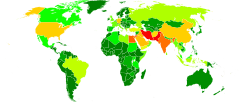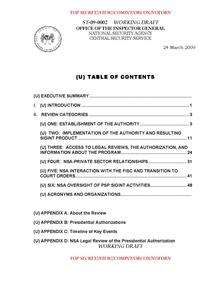Stellar Wind
 National Security Agency surveillance |
|---|
 |
|
Programs
|
|
Institutions |
|
Whistleblowers |
 2009 OIG Draft Report on Stellar Wind |
Stellar Wind or Stellarwind is the code name of information collected under the President's Surveillance Program (PSP).[1] The National Security Agency (NSA) program was approved by President George W. Bush shortly after the September 11, 2001 attacks and was revealed by Thomas Tamm to The New York Times in 2008.[2][3] Stellar Wind was a prelude to new legal structures that allowed President Bush and President Barack Obama to reproduce each of those programs and expand their reach.[4]
Scope of the program
The program's activities involved data mining of a large database of the communications of American citizens, including e-mail communications, telephone conversations, financial transactions, and Internet activity.[3] William Binney, a retired technical leader with the NSA, discussed some of the architectural and operational elements of the program at the 2012 Chaos Communication Congress.[5]
The intelligence community also was able to obtain from the U.S. Treasury Department suspicious activity reports, or "SARS", which are reports of activities such as large cash transactions that are submitted by financial institutions under anti-money laundering rules.[3]
There were internal disputes within the U.S. Justice Department about the legality of the program, because data are collected for large numbers of people, not just the subjects of Foreign Intelligence Surveillance Act (FISA) warrants.[5][6] During the Bush Administration, the Stellarwind cases were referred to by FBI agents as "pizza cases" because many seemingly suspicious cases turned out to be food takeout orders. According to then-FBI Director Robert Mueller, approximately 99% of the cases led nowhere, but "it's that other 1% that we've got to be concerned about".[2]
2004 conflict
From a report by the inspectors general of six US intelligence agencies that was declassified in September 2015, it became clear that President Bush had originally authorized the collection of telephone and e-mail metadata only if one end of the communications was foreign or when there was a link to terrorism. But in 2004, the Justice Department found out that the NSA was apparently also collecting the metadata of purely domestic communications, after which President Bush declared that NSA had always been allowed to do so, but that analysts were only allowed to look at metadata related to terrorism. With this revised formulation, Bush reauthorized the program on March 11, 2004.[7]
In 2004, the head of the Office of Legal Counsel, Jack Landman Goldsmith, wrote at least two legal memos authorizing the program, "We conclude only that when the nation has been thrust into an armed conflict by a foreign attack on the United States and the president determines in his role as commander in chief ... that it is essential for defense against a further foreign attack to use the [wiretapping] capabilities of the [National Security Agency] within the United States, he has inherent constitutional authority" to order warrantless wiretapping—"an authority that Congress cannot curtail," Goldsmith wrote in a 108-page memo dated May 6, 2004. In March 2004, the OLC concluded the e-mail program was not legal, and then-Acting Attorney General James Comey refused to reauthorize it.[8]
Revelations
In March 2012 Wired magazine published "The NSA Is Building the Country's Biggest Spy Center (Watch What You Say)" talking about a vast new NSA facility in Utah and said, "For the first time, a former NSA official has gone on the record to describe the program, codenamed Stellarwind, in detail," naming the official William Binney, a former NSA code breaker. Binney went on to say that the NSA had highly secured rooms that tap into major switches, and satellite communications at both AT&T and Verizon.[9] The article suggested that the supposedly-dispatched Stellarwind continues as an active program. This conclusion was supported by the exposure of Room 641A in AT&T's operations center in San Francisco in 2006.
In June 2013 the Washington Post and the Guardian published an OIG draft report, dated March 2009, leaked by Edward Snowden detailing the Stellarwind program.[1][10] No doubt remained about the continuing nature of the surveillance program.
In September 2014 The New York Times asserted, "Questions persist after the release of a newly declassified version of a legal memo approving the National Security Agency's Stellarwind program, a set of warrantless surveillance and data collection activities secretly authorized after the terrorist attacks of Sept. 11, 2001." as an introductory headline summary with a link. The accompanying article addressed the release of a newly declassified version of the May 2004 memo.[11] Note was made that the bulk of the program, the telephone, Internet, and e-mail surveillance of American citizens, remained secret until the revelations by Edward Snowden and that to date, significant portions of the memo remain redacted in the newly released version, as well as, that doubts and questions about its legality persist.
See also
- 2013 mass surveillance disclosures
- Hepting v. AT&T (warrantless wiretapping case)
- MUSCULAR
- NSA call database
- NSA electronic surveillance program
- NSA warrantless surveillance controversy
- President's Surveillance Program: Ashcroft hospital bedside meeting
- PRISM
References
- 1 2 NSA Inspector General report on the President's Surveillance Program, March 24, 2009, page 10, note 3.
- 1 2 "Is the FBI Up to the Job 10 Years After 9/11?" April 28, 2011
- 1 2 3 Isikoff, Michael (December 13, 2008). "The Fed Who Blew the Whistle: Is he a hero or a criminal?". Newsweek. Archived from the original on December 15, 2008.
- ↑ Gellman, Barton (June 16, 2013). "U.S. surveillance architecture includes collection of revealing Internet, phone metadata". The Washington Post.
- 1 2 Binney, William. 29C3 Panel: Jesselyn Radack, Thomas Drake, William Binney on whistleblowing and surveillance (Flash) (YouTube Video). Hamburg, Germany: Chaos Communication Congress. Event occurs at 1:03:00. Retrieved June 9, 2013.
- ↑ Sanchez, Julian (July 29, 2013). "What the Ashcroft 'Hospital Showdown' on NSA spying was all about". Retrieved 2013-07-29.
- ↑ Charlie Savage (2015-09-20). "George W. Bush Made Retroactive N.S.A. 'Fix' After Hospital Room Showdown"". New York Times.
- ↑ Nakashima, Ellen (6 September 2014). "Legal memos released on Bush-era justification for warrantless wiretapping". Washington Post.
- ↑ Bamford, James (March 15, 2012). "The NSA Is Building the Country's Biggest Spy Center (Watch What You Say)". Wired. Retrieved March 15, 2012.
- ↑ "NSA inspector general report on email and internet data collection under Stellar Wind". March 9, 2009. Retrieved August 1, 2013.
- ↑ Savage, Charlie, Redactions in U.S. Memo Leave Doubts on Data Surveillance Program, The New York Times, Sunday, September 7, 2014, New York edition, page A17
External links
- NSA inspector general report on email and internet data collection under Stellar Wind – full document, The Guardian, June 27, 2013.
- Poitras, Laura. The Program. Nytimes.com, Op-Docs, August 22, 2012.